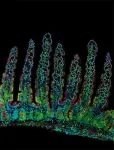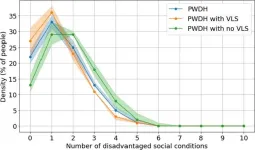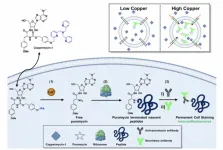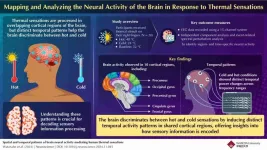(Press-News.org)
In the world of modern optics, frequency combs are invaluable tools. These devices act as rulers for measuring light, enabling breakthroughs in telecommunications, environmental monitoring, and even astrophysics. But building compact and efficient frequency combs has been a challenge—until now.
Electro-optic frequency combs, introduced in 1993, showed promise in generating optical combs through cascaded phase modulation but progress slowed down because of their high power demands and limited bandwidth. This led to the field being dominated by femtosecond lasers and Kerr soliton microcombs, which, while effective, require complex tuning and high power, limiting field-ready use.
But recent advances in thin-film electro-optic integrated photonic circuits have renewed interest, with materials like lithium niobate. Nonetheless, achieving broader bandwidth with lower power has remained a challenge, the intrinsic birefringence (splitting light beams) of the lithium niobate also sets a upper limit for the achievable bandwidth.
Scientists at EPFL, the Colorado School of Mines and the China Academy of Science, has now tackled this by combining microwave and optical circuit designs on the newly developed lithium tantalate platform, compared with lithium niobate, the lithium tantalate features 17 times lower intrinsic birefringence. Led by Professor Tobias J. Kippenberg, the researchers developed an electro-optic frequency comb generator that achieves an unprecedented 450 nm spectral coverage with over 2000 comb lines. The breakthrough expands the device’s bandwidth and reduces microwave power requirements almost 20-fold compared to previous designs.
The team introduced a “integrated triply resonant” architecture, where three interacting fields—two optical and one microwave—resonate in harmony. This was achieved using a novel co-designed system that integrates monolithic microwave circuits with photonic components. By embedding a distributed coplanar waveguide resonator on lithium tantalate photonics integrated circuits, the team significantly improved microwave confinement and energy efficiency.
The device’s compact size, fitting within a 1x1 cm² footprint, was made possible by leveraging lithium tantalate’s lower birefringence. This minimizes interference between light waves, which enables smooth and consistent frequency comb generation. Additionally, the device operates using a simple, free-running distributed feedback laser diode, making it far more user-friendly than its Kerr soliton counterparts.
The new comb generator’s ultra-broadband span, covering 450 nm, exceeds the limits of current electro-optic frequency comb technologies. It achieves this with stable operation across 90% of the free spectral range, eliminating the need for complex tuning mechanisms. This stability and simplicity open the door to practical, field-deployable applications.
The new device can be a paradigm shift in the world of photonics. With its robust design and compact footprint, it can impact areas like robotics, where precise laser ranging is crucial, and environmental monitoring, where accurate gas sensing is essential. Moreover, the success of this co-design methodology highlights the untapped potential of integrating microwave and photonic engineering for next-generation devices.
All samples were fabricated in the EPFL Center of MicroNanoTechnology (CMi) and the Institute of Physics (IPHYS) cleanroom. The LTOI wafers were fabricated in Shanghai Novel Si Integration Technology (NSIT) and the SIMIT-CAS.
Reference
Junyin Zhang, Chengli Wang, Connor Denney, Johann Riemensberger, Grigory Lihachev, Jianqi Hu, Wil Kao, Terence Blésin, Nikolai Kuznetsov, Zihan Li, Mikhail Churaev, Xin Ou, Gabriel Santamaria-Botello, Tobias J. Kippenberg. Ultrabroadband integrated electro-optic frequency comb in lithium tantalate. Nature 22 January 2024. DOI: 10.1038/s41586-024-08354-4
END
Seattle, WASH.—January 22, 2025—The human immune system is like an army of specialized soldiers (immune cells) each with a unique role to play in fighting disease. In a new study published in Nature, led by scientists at the Allen Institute, La Jolla Institute for Immunology, and UC San Diego, researchers reveal how cells known as tissue-resident memory CD8 T cells, play unique and specialized roles based on where they are located within the small intestine. Tissue-resident memory cells provide a local first ...
Thanks to a new technology called Moscot (“Multi-Omics Single-Cell Optimal Transport”), researchers can now observe millions of cells simultaneously as they develop into a new organ—for example, a pancreas. This groundbreaking method was developed by an international research team led by Helmholtz Munich and has been published in the renowned journal Nature.
Until now, biologists had only a limited understanding of how cells develop in their natural environment—for instance, when they form an organ in the ...
January 22, 2025
New Study Finds Social Programs Could Reduce the Spread of HIV by 29%
Although HIV was used as a case study, the UMass Amherst researchers say their assessment tool has applications for other diseases
AMHERST, Mass. — Researchers at the University of Massachusetts Amherst have quantified the impacts of a constellation of social factors on the spread of HIV. Their study, published in Health Care Management Science, found that a hypothetical 100% effective intervention addressing barriers to HIV treatment and care from depression, homelessness, ...
New University of Virginia School of Medicine research revealing the fingerprints of Sudden Infant Death Syndrome within blood samples could open the door to simple tests to identify babies at risk.
The findings also represent an important step forward in unraveling the causes of SIDS, an unexplained condition that is the No. 1 killer of babies between amonth and a year old.
The UVA researchers analyzed blood serum samples collected from infants who died ...
Ozone (O3) exposure may reduce the availability of oxygen in the body, resulting in arterial stiffening due to the body’s natural response to create more red blood cells and hemoglobin, according to a study published today in JACC, the flagship journal of the American College of Cardiology.
“Researchers found that even brief exposure to elevated ozone levels reduced blood oxygen saturation, triggered hypoxia-related biomarkers, and increased arterial stiffness, highlighting the novel connection between ozone exposure and arterial stiffness, demonstrated through comprehensive biomarker analysis in a high-altitude ...
The Chang Lab at Princeton Chemistry continues in its mission to elucidate the role of metal nutrients in human biology: last year, iron; this year, copper. The lab’s first paper of 2025 showcases its development of a revelatory sensing probe for the detection of copper in human cells and then wields it to uncover how copper may be regulating cell growth in lung cancer.
Researchers also offer a possible treatment modality in which copper chelation shows promising results in certain lung cancers where cells have two related phenomena: a heightened transcription factor responding to oxidative stress and a diminished level of bioavailable copper.
Their collaborative paper, A histochemical ...
Despite significant therapeutic advances, breast cancer remains a leading cause of cancer-related death in women. Treatment typically involves surgery and follow-up hormone therapy, but late effects of these treatments include osteoporosis, sexual dysfunction and blood clots. Now, researchers reporting in ACS Central Science have created a novel treatment that eliminated small breast tumors and significantly shrank large tumors in mice in a single dose, without problematic side effects.
Most breast cancers are ...
PULLMAN, Wash. – When it comes to getting people to want to go places, the future is ever more lovely than the past, according to a new Washington State University-led study in the Journal of Hospitality and Tourism Research.
Led by Ruiying Cai, an assistant professor in the Carson College of Business, the study found that forestalgia-focused destination ads—those that emphasize an idealized future—are more effective at enticing travelers to click the purchase button for a vacation than ads based on fond recollections. The research also revealed that forestalgia advertising is particularly effective for getting people to book near-term trips, as imagining ...
COLUMBUS, Ohio – Black immigrants moving into a neighborhood can help shift the overall racial and ethnic character of the area, a new study suggests.
A researcher from The Ohio State University found that when Black immigrants move into a majority native-Black neighborhood, there is an increase in the white population moving in while native Black residents move out.
“Blackness can’t be treated as a monolith within the United States today, where there is a growing Black immigrant population,” said Nima Dahir, author of the study and assistant professor of sociology at Ohio State.
“There is a lot of complexity ...
When we touch something hot or cold, the temperature is consciously sensed. Previous studies have shown that the cortex, the outermost layer of the brain, is responsible for thermal sensations. However, how the cortex determines whether something is hot or cold is not well understood. Thermal sensitivity is often subjective and individualistic; what is a comfortable temperature for someone might be too hot or too cold for someone else.
In a new study, Professor Kei Nagashima from the Body Temperature and Fluid Laboratory, Faculty of Human Sciences, ...




